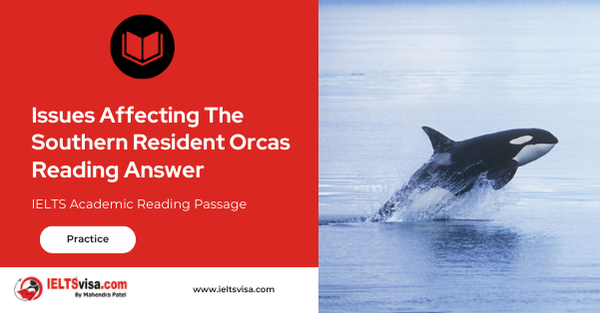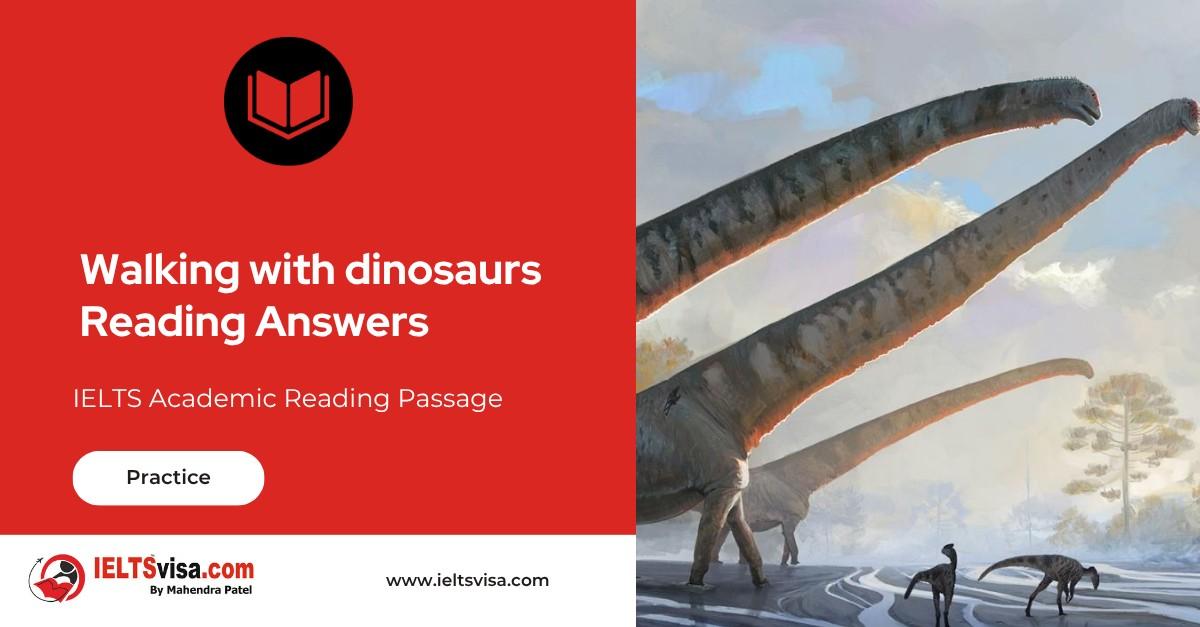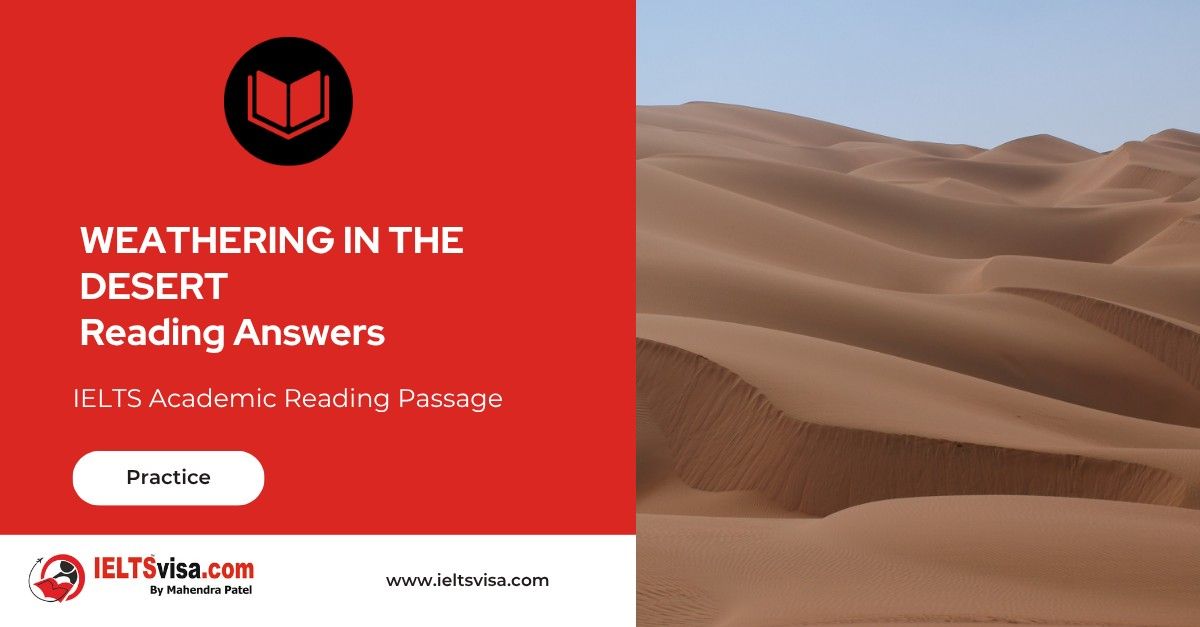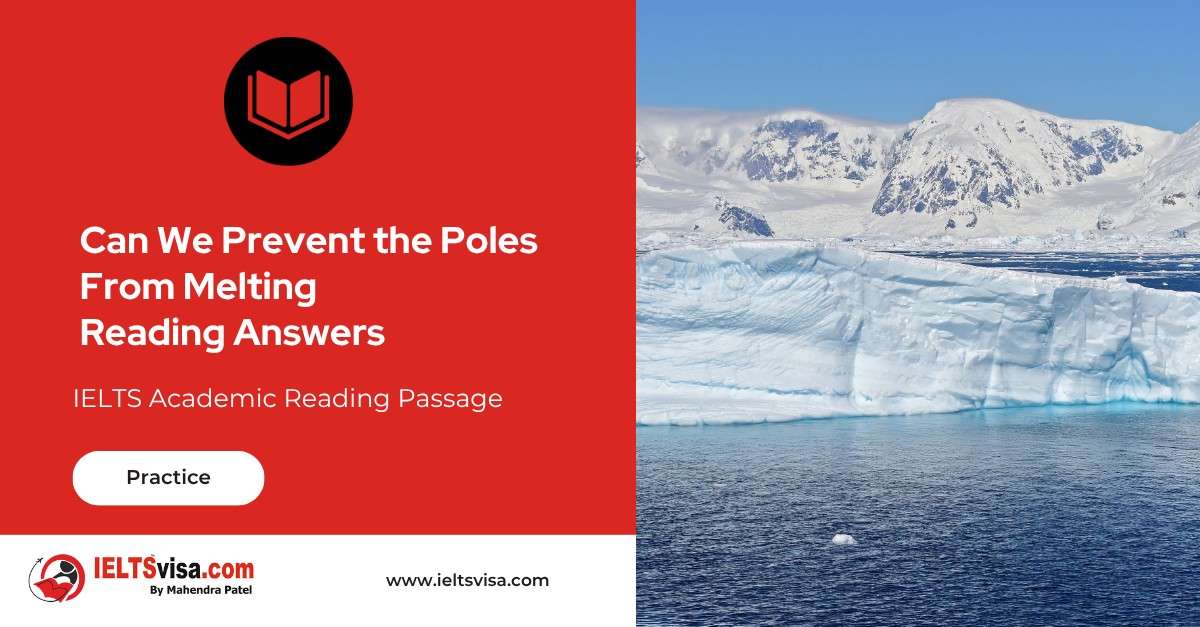Issues Affecting The Southern Resident Orcas Reading Answer
IELTS Academic Reading Passage
A
Orcas, also known as killer whales, are opportunistic feeders, which means they will take a variety of different prey species. J, K, and L pods (specific groups of orcas found in the region) are almost exclusively fish eaters. Some studies show that up to 90 percent of their diet is salmon, with Chinook salmon being far and away their favorite. During the last 50 years, hundreds of wild runs of salmon have become extinct due to habitat loss and overfishing of wild stocks. Many of the extinct salmon stocks are the winter runs of chinook and coho. Although the surviving stocks have probably been sufficient to sustain the resident pods, many of the runs that have been lost were undoubtedly traditional resources favored by the resident orcas. This may be affecting the whales’ nutrition in the winter and may require them to change their patterns of movement in order to search for food.
Other studies with tagged whales have shown that they regularly dive up to 800 feet in this area.
Researchers tend to think that during these deep dives the whales may be feeding on bottomfish. Bottomfish species in this area would include halibut, rockfish, lingcod, and greenling. Scientists estimate that today’s lingcod population in northern Puget Sound and the Strait of Georgia is only 2 percent of what it was in 1950. The average size of rockfish in the recreational catch has also declined by several inches since the 1970s, which is indicative of overfishing. In some locations, certain rockfish species have disappeared entirely. So even if bottomfish are not a major food resource for the whales, the present low numbers of available fish increases the pressure on orcas and all marine animals to find food. (For more information on bottomfish see the San Juan County Bottomfish Recovery Program.)
B
Toxic substances accumulate in higher concentrations as they move up the food chain. Because orcas t are the top predator in the ocean and are at the top of several different food chains in the environment, they tend to be more affected by pollutants than other sea creatures. Examinations of stranded killer whales have shown some extremely high levels of lead, mercury, and polychlorinated hydrocarbons. Abandoned marine toxic waste dumps and present levels of industrial and human refuse pollution of the inland waters probably presents the most serious threat to the continued existence of this orca population. Unfortunately, the total remedy to this huge problem would be broad societal changes on many fronts. But because of the fact that orcas are so popular, they may be the best species to use as a focal point in bringing about the many changes that need to be made in order to protect the marine environment as a whole from further toxic poisoning.’
C
The waters around the San Juan Islands are extremely busy due to international commercial shipping, fishing, whale watching, and pleasure boating. On a busy weekend day in the summer, it is not uncommon to see numerous boats in the vicinity of the whales as they travel through the area. The potential impacts from all this vessel traffic with regard to the whales and other marine animals in the area could be tremendous.
The surfacing and breathing space of marine birds and mammals is a critical aspect of their habitat, which the animals must consciously deal with on a moment-to-moment basis throughout their lifetimes. With all the boating activity in the vicinity, there are three ways in which surface impacts are most likely to affect marine animals: (a) collision, (b) collision avoidance, and (c) exhaust emissions in breathing pockets.
The first two impacts are very obvious and don’t just apply to vessels with motors. Kayakers even present a problem here because they’re so quiet. Marine animals, busy hunting and feeding under the surface of the water, may not be aware that there is a kayak above them and actually hit the bottom of it as they surface to breathe.
The third impact is one most people don’t even think of. When there are numerous boats in the area, especially idling boats, there are a lot of exhaust fumes being spewed out on the surface of the water. When the whale comes up to take a nice big breath of “fresh” air, it instead gets a nice big breath of exhaust fumes. It’s hard to say how greatly this affects the animals, but think how breathing polluted air affects us (i.e., smog in large cities like Los Angeles, breathing the foul air while sitting in traffic jams, etc)._
D
Similar to surface impacts, a primary source of acoustic pollution for this population of orcas would also be derived from the cumulative underwater noise of vessel traffic. For cetaceans, the underwater sound environment is perhaps the most critical component of their sensory and behavioral lives. Orcas communicate with each other over short and long distances with a variety of clicks, chirps, squeaks, and whistles, along with using echolocation to locate prey and to navigate. They may also rely on passive listening as a primary sensory source. The long-term impacts from noise pollution would not likely show up as noticeable behavioral changes in habitat use, but rather as sensory damage or gradual reduction in population health. A new study at The Whale Museum called the SeaSound Remote Sensing Network has begun studying underwater acoustics and its relationship to orca communication.
Questions 1-4
Reading Passage 3 has four sections (A-D). Choose the most suitable heading for each section from the list of headings below.
Write the appropriate numbers (i-vii) in boxes 1-4 on your Answer Sheet There are more headings than sections, so you will not use all of them.
List of Headings
i Top Ocean Predators
ii Toxic Exposure
iii Declining Fish Populations
iv Pleasure Boating in the San Juan Is
v Underwater Noise
vi Smog in Large Cities vii Impact of B
vii viiImpact of Boat Traffic
1. Section A
2. Section B
3. Section C
4. Section D
Questions 5-6
For each question, choose the appropriate letter A-D and write it in boxes 5 and 6 on your Answer Sheet
5. Killer whales (orcas) in the J, K, and L pods prefer to eat
A halibut.
B a type of salmon.
C a variety of animals.
D fish living at the bottom of the sea.
6. Some groups of salmon have become extinct because
A they have lost places to live.
B whales have eaten them.
C they don’t get good nutrition.
D the winters in the area are too cold.
Questions 7-14
Complete the chart below.
Choose NO MORE THAN THREE WORDS for each answer.
|
Cause |
Effect |
| Scientists believe some whales feed 7……………….. | These whales dive very deep. |
| Scientists believe that the area is being over fished. |
Rockfish caught today is 8………….. caught in the past. |
| Orcas are at the top of the ocean food chain. |
9………………affects orcas more than it sea animals. |
| Orcas are a 10……………. species. |
We can use orcas to make society aware problem of marine pollution |
|
People enjoy boating, fishing, and whale watching in the San Juan Islands. |
On weekends there are 11………………… whales. |
| Kayaks are 12……………. | Marine animals hit them when they come |
| A lot of boats beep their motors running. | Whales breathe 13…………… |
| Boats are noisy. | Whales have difficulty 14………….. |

Solutions For:- Issues Affecting The Southern Resident Orcas Reading Answer
| 1. iii | 8. less |
| 2. ii | 9. pollution |
| 3. vii | 10. popular |
| 4. v | 11. numerous boats/vessels |
| 5. B | 12. quiet |
| 6. A | 13. exhaust fumes |
| 7. (on) bottomfish | 14. communicating (with others) |
Review and Practice
- Regularly practice with IELTS reading samples and time yourself to get used to the pressure of the exam.
- Review your mistakes to understand where you went wrong and how to avoid similar errors in the future.
Our Books
Master IELTS Speaking Part 1
IELTS Writing Task 1 Book
IELTS Writing Task 2 Book
Issues Affecting The Southern Resident Orcas Reading Answer Explanation
Comin Soon
Practice IELTS Other Modules
IELTS Listening
The IELTS Listening test assesses how well you can understand spoken English in various contexts. It lasts about 30 minutes and is divided into four sections with a total of 40 questions. The listening tasks become increasingly difficult as the test progresses.
IELTS Academic Reading
The IELTS Academic Reading section assesses your ability to understand and interpret a variety of texts in academic settings. It is designed to evaluate a range of reading skills, including skimming for gist, reading for main ideas, reading for detail, understanding inferences, and recognizing a writer's opinions and arguments.
IELTS Speaking
The IELTS Speaking test assesses your ability to communicate in English on everyday topics. It lasts 11-14 minutes and consists of three parts: introduction, cue card, and a discussion based on the cue card topic.
IELTS General Reading
IELTS General Reading tests your ability to understand and interpret various types of texts. Here are some key areas and types of content you can expect to encounter in the reading section, along with tips for effective preparation.
IELTS Academic Writing Task 1
In IELTS Academic Writing Task 1, you are presented with a visual representation of information, such as graphs, charts, tables, or diagrams, and you are required to summarize, compare, or explain the data in your own words.
IELTS General Writing Task 1
In IELTS General Writing Task 1, you are required to write a letter based on a given situation. The letter can be formal, semi-formal, or informal, depending on the prompt. Here’s a breakdown of the key components to include in your letter
IELTS Academic Writing Task 2
In IELTS Academic Writing Task 2, you are required to write an essay in response to a question or topic. Here’s a guide to help you understand the essential elements of this task
IELTS Exam Tips
To succeed in the IELTS exam, practice regularly, familiarize yourself with the test format, improve your vocabulary, develop time management skills, and take mock tests to build confidence.
Grammer for IELTS
Grammar is the foundation of effective communication in English. Understanding tense usage, subject-verb agreement, and sentence structure enhances clarity and coherence in writing and speaking.
Vocabulary for IELTS
Vocabulary plays a crucial role in the IELTS (International English Language Testing System) exam, especially in the Speaking and Writing sections. Here’s an overview of why vocabulary is important and how it impacts your performance
RECENT IELTS SAMPLES QUESTIONS AND ANSWERS
Walking with dinosaurs
Peter L. Falkingham and his colleagues at Manchester University are developing techniques that...
Money as the Unit of Amount Reading Answers
The most difficult aspect of money to understand is its function as a unit of account. In...
WEATHERING IN THE DESERT
In the deserts, as elsewhere, rocks at the earth's surface are changed by weathering, which...
Nature on Display in American Zoos
The first zoo in the United States opened in Philadelphia in 1874, followed by the Cincinnati...
Can We Prevent the Poles From Melting
Such is our dependence on fossil fuels, and such is the volume of carbon dioxide we have...
Air conditioning the earth reading answers
The circulation of air in the atmosphere is activated by convection, the transference of heat...













